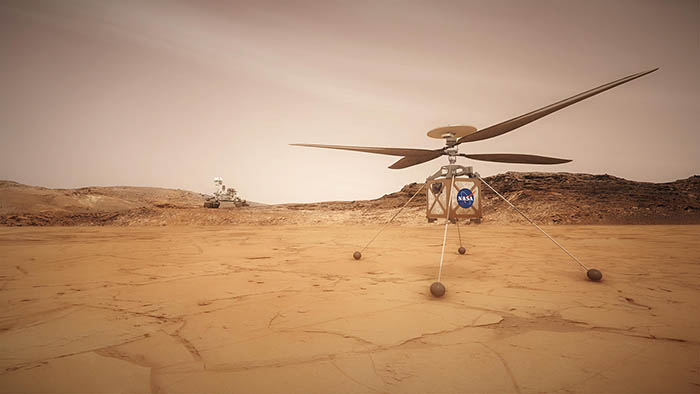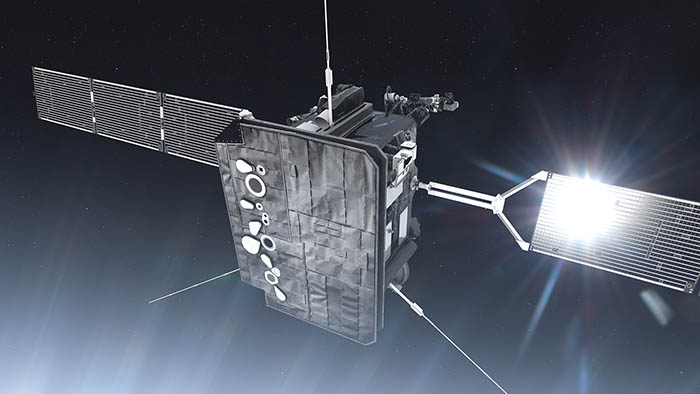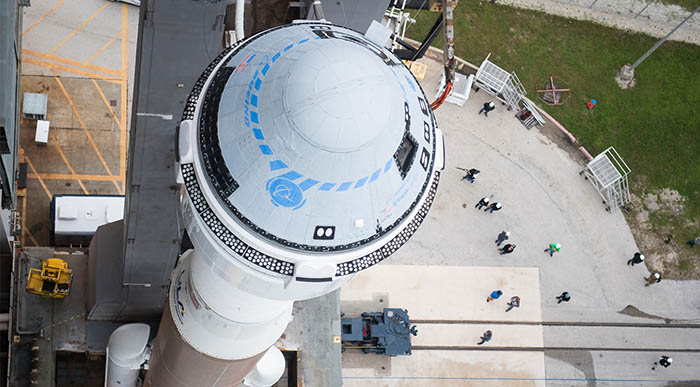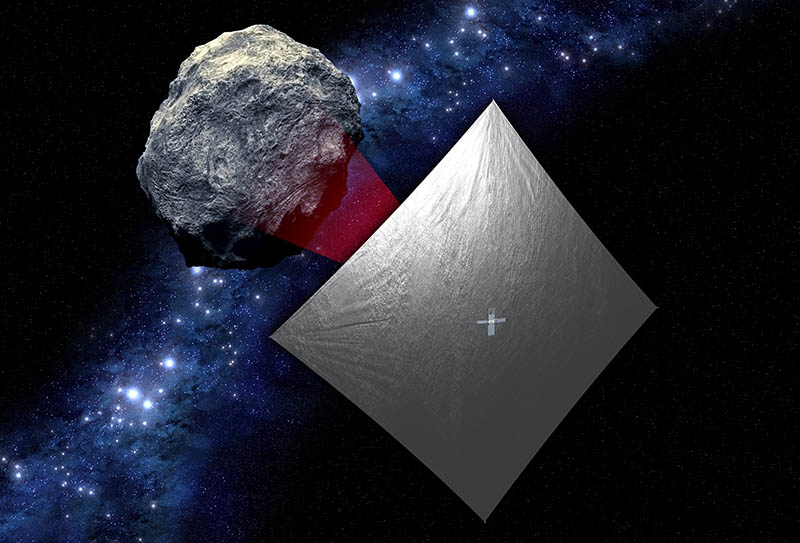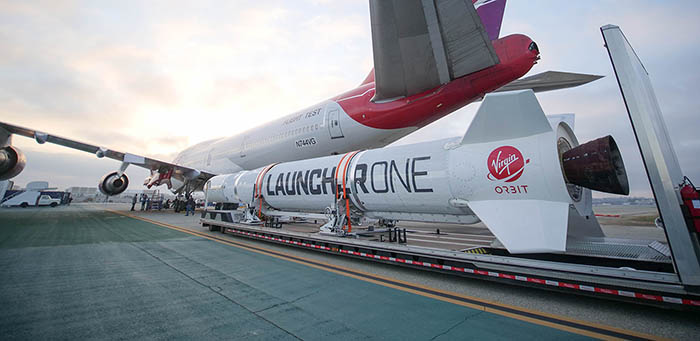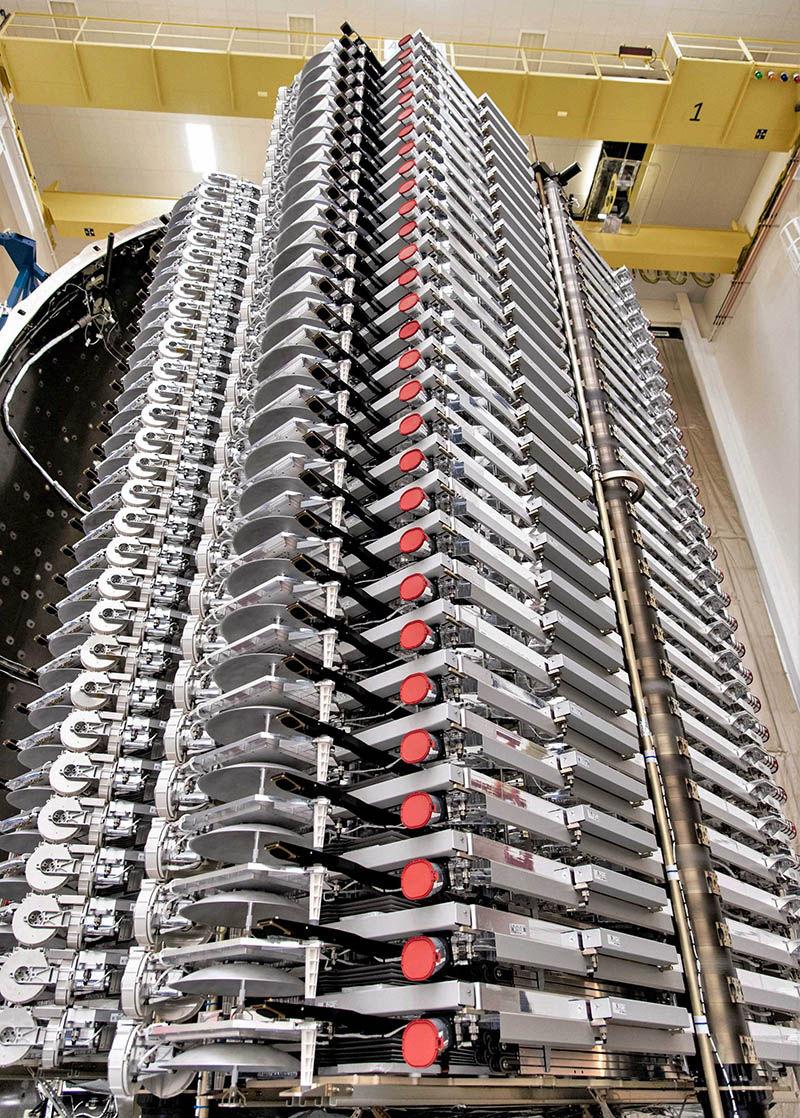03 January 2020 || 11 minute read
Title image is ESA's ExoMars rover, Rosalind Franklin, (foreground) and Russia's stationary surface science platform, Kazachok, (background) are scheduled for launch in July 2020, arriving at Mars in March 2021. Image credit: ESA
It’s 2020, the year by which we were promised so much. By the likes of me. So, what will 2020 actually bring for the space sector?
Let’s start by looking back. In 1997, the Futurists Peter Schwartz & Peter Leyden predicted in Wired that humans would land on Mars in the year 2020. They won’t. It always an optimistic prediction, and I’d suggest its only marginally more likely today that humans will go to Mars within the next twenty-years. But, whilst no human is going to Mars anytime soon, 2020 is starting to look like a big year for Mars exploration.
The return to flight at the end of 2019 of the Long March 5 rocket has cleared the way for any array of Chinese space activity that has been at risk since the Long March 5 launch failure in 2017. Included in this is the Mars Global Remote Sensing Orbiter and Small Rover, temporarily named Huoxing-1 (meaning Mars-1), from the China National Space Administration and due for launch in July. This would be China’s first independent mission beyond the Moon, and follows the launch failure of their only previous Mars attempt, Yinghuo-1, which was a piggy-back on Russia’s Fobos-Grunt mission in January 2012.
In Europe, the ExoMars collaboration with Russia is set for lift-off again in 2020 with the planned launch of the Rosalind Franklin rover and Kazachok(meaning little Cossack) surface platform towards Mars in July. This programme has had a number of challenges, notably including the crash landing on Mars of the Schiaparelli surface module in 2016, and a launch delay from the last Mars launch window in 2018. Nevertheless, recent positive test results for the parachutes have hopefully kept the mission launch on-track to pursue its objectives to search for possible signs of past microbial life on Mars, to study both the surface and subsurface environment, and the planet’s interior, and to advance towards a possible Mars Sample Return mission in the future.
Completing the tripartite of Mars landers launching in July will be the latest Mars rover from NASA-JPL, the currently unnamed Mars 2020. This rover is based on the design of the previous Curiosity rover, and will carry a payload including a core drill and the Mars Helicopter Scout, a less than 2 kg, 80 cm tall helicopter that will fly for up to 90 seconds to an altitude of less than 400 metres with two on-board cameras. The helicopter is no-doubt eye-catching, however the main science goals are aligned with those of ExoMars; to search for signs of habitable conditions on Mars in the ancient past, and evidence of past microbial life. The rover will also collect and cache across the surface of Mars a number of returnable rock cores and soil samples, again aiding progress towards a possible future Mars Sample Return mission.
Also launching in July is the Emirates Mars Mission, Hope, a 1500kg Mars orbiter from UAE built by the Mohammed bin Rashid Space Centre, the University of Colorado, and Arizona State University, and to be launched from Japan. This orbiter aims to further our understanding of the Martian atmosphere, and its layers, seeking to answer questions about the processes that drive the loss of hydrogen and oxygen from the planet. If successful it will also mark the arrival of UAE as more than a bit-part space-faring nation, as they join the handful of countries to have orbited Mars. To the end of 2019, only the USA, the Soviet Union, Europe, and India have done so. Of note, other than in partnership with Europe, Russia has not done so since the end of the Soviet Union.
All of these Mars missions, if launched in late-July / early-August as planned, will arrive at Mars in early 2021. Any delay now to these missions could mean a launch slippage to 2022, the next Mars launch window.
Elsewhere, other science highlights of 2020 should include the long-delayed launch of ESA’s Solar Orbiter, Europe’s closest ever mission to the Sun, performing close-up, high-resolution studies of the Sun and its inner heliosphere. The mission is a collaboration with NASA, who will provide the launch, which is currently scheduled for February, and the science observations will be coordinated with NASA’s Parker Solar Probe to maximise the combined science return. Meanwhile, following the crash landing of Chandrayaan-2 onto the Moon in September 2019 that contributed to a diplomatic spat with Pakistan over “irresponsible” use of space and the creation of debris, India aims to launch Chandrayaan-3, in-effect a rebuild of the Chandrayaan-2 surface elements as the Chandrayaan-2 orbiter continues to operate well, in November 2020, although ISRO recognises that launch might slip into 2021.
And, what of the successor to the Hubble Space Telescope, the James Webb Telescope? Well, that still another year away. For now.
The successful return of the Long March 5 launcher should also clear the way Chang’e-5 lunar sample return mission to launch in late-2020. If successful China would be only the third country to return samples from the Moon, with these being the first since the Soviet Union’s Luna-24 in 1976. China’s ultimate aim through the coming decade is to establish a robotic lunar research base as a pre-curser to crewed lunar missions.
The return to flight of Long March 5 should also clear the way for a test of the Long March 5B in 2020, likely after the launch of Huoxing-1 but before the launch of Chang’e-5, carrying an uncrewed prototype for a crewed craft for deep space. A successful demonstration of the LM5B in-turn would clear the way for China to resume development of its low-Earth orbit space station in 2021 with launch of Tianhe, the core module of this station.
Elsewhere in the field of human spaceflight, ESA will hopefully be sending the European Robotic Arm to the International Space Station. The arm will work with the new Russian airlock, transferring small payloads directly from inside to outside the Station, reducing the setup time for astronauts on a spacewalk, and allowing the arm to work alongside astronauts. The arm will also transport astronauts around the station’s exterior.
However, this is unlikely to be the highlight of the human spaceflight year. India aims to launch the first, uncrewed test-flight of Gaganyaan in late-2020, an important to stepping stone towards India becoming only the fourth country to independently put people in space with their first crewed mission, if all goes to plan, in late-2021 or 2022 to coincide with celebrations to mark 75-years of independence from the United Kingdom.
We should also finally see NASA’s Commercial Crew programme, perhaps, once again provide America with crewed access to low-Earth orbit from US soil for the first time since the Shuttle was retired in 2011. Despite the difficult test-flight of Boeing’s Starliner in December, we can still hope for at least one crewed mission in 2020. The plan prior to the orbital test flight had been for two, a crewed test-flight and the first operational flight, which might now slip into 2021.
Meanwhile, SpaceX’s Crew Dragon, or Dragon-2, finished 2019 with a serious of positive parachute tests, and is targeting an in-flight abort test in early 2020 ahead of a first crewed flight, if all goes to plan, before the end of Q1 2020. This would allow the first operational flight before the end of 2020 to deliver the ISS Expedition 64/65 crew, comprised of two American and one Japanese astronaut.
This year should, hopefully, also see the maiden flight of NASA’s Space Launch System with the Artemis-1 mission, the first integrated launcher with the Orion spacecraft. Of note, this is not the final or full version of the planned massive Space Launch System, and will actually only be the lower stages of that final rocket. Artemis should form the basis of NASA’s future deep-space exploration activities, including planned crewed lunar flights of the Artemis program, targeting an improbable crewed Lunar landing by 2024 with the first woman and next man, and a possible follow-on human mission to Mars. The maiden flight will carry a number of small satellites towards the Moon, including the Near-Earth Asteroid Scout mission. this will be the first mission with a truly operational solar sail, a much-vaunted form of propellantless propulsion that reflects sunlight rather than using stored propellant as its primary form of propulsion.
Other systems designed to reach space should also start to fly in 2020. After publicly listing on the New York Stock Exchange in 2019, Virgin Galactic will be targeting their elusive first commercial flight of SpaceShipTwo in 2020, and to start flying the long-patient 600+ customers who have paid 250k$ each for a 90-minute sub-orbital flight.
Blue Origin will also be progressing towards crewed sub-orbital flights with the maiden flight of New Shepard 4 expected this year. This vehicle should be able to carry crew although Blue Origin are notoriously cautious about public statements or schedule commitments, so when crewed or commercial flights will begin remains unclear. But, watch out for something this year.
Staying with new launchers, this year should see the maiden launch of Virgin Orbit’s LauncherOne, the two-stage air-launched rocket targeting the small satellite market. A successful demonstration of LauncherOne has the potential, according to Virgin Orbit, to bring space launch to any airport in the World that can support a Boeing 747, subject to local legislation, further democratising, and localising access to space. Meanwhile in China, preparations are on-going for the maiden flight of the new Long March 8 rocket, a kerosene-liquid oxygen rocket that will attempt both vertical take-off and landing, a first for China. Curiously, animations appear to suggest the two side-boosters will remain attached to the first-stage throughout the landing sequence.
Increased reusability should be welcome for those living down-range of Xichang Satellite Launch Center, China’s busiest. Especially those in rural Sichuan province as it should reduce the number of rocket stages being dropped onto villages causing death and destruction to the voiceless. It should also reduce the need for the clearly ludicrous instructions to residents that if they “see any flying objects falling from the sky, please adjust your location quickly to avoid any harm.” For all of China’s achievements in science and technology, and especially in the space sector, the very real cost to the poor in that country must never be overlooked. It can surely never be acceptable to risk the life of bystanders, or in this case those under the flight-path, to such an extent to advance technology. Indeed, we must recognise it as achieving the opposite of showcasing a country’s advancements, especially when those deaths enable that country in 2020 to deploy the World’s third operational Global Navigation Satellite System, Beidou, and to claim they seek only to “serve the world and benefit mankind”.
On the commercial side, this year should be pivotal for several companies, including Capella Space who hope to begin commercial operations with launch of seven synthetic aperture radar spacecraft, and two emerging radio-frequency geolocation companies HawkEye 360 and Kleos Space, as both bring a new, and potentially very valuable type of data product to the civil, commercial data market. We will also see the continued emergence of China’s commercial space sector, a consequence of a policy shift just over five years ago to open up the launch and small satellite sectors to private capital. This has led to companies like GalaxySpace, who have already raised over 14M$ and are due to launch a test 5G communications spacecraft in January, and others raising almost 1.5B$ in venture funding since then. This increase in commercial activity will further drive an increase in launch activity from China, likely to over 40 launches in 2020.
SpaceX are also likely to be grabbing headlines, good and bad, with their Starlink (low-Earth orbiting broadband) constellation as they look set to significantly accelerate the launch cadence of these, as well as beginning commercial operations through 2020. SpaceX are looking to establish an average launch cadence of every two weeks, firmly establishing SpaceX as the operator of Earth’s largest spacecraft constellation. By the end of 2020 the Starlink constellation could be over 1500 spacecraft. Although this seems optimistic as it requires no anomalies or delays as they attempt to ramp up activity.
To the end of 2019 we have collectively launched fewer than 9000 spacecraft, with around 2000 remaining operational; around two-thirds of which are in low-Earth orbit. This means that by the end of 2020, its conceivable SpaceX could be responsible for around half of all spacecraft in low-Earth orbit, and over a third of all operational spacecraft! By the mid-2020’s the plan is for Starlink to have around 12000 spacecraft in the constellation, rising to perhaps as many as 42000 spacecraft beyond that.
Other so-called mega-constellations will also be stepping up activity in 2020, with OneWeb due to launch 34 spacecraft, of an initial 650, early in the year from a Soyuz launch, whilst the overdue confirmation from Telesat is expected to confirm who they will partner with for the manufacturing of the 200 spacecraft they hope to have in-orbit by 2022. And, we can perhaps expect to slowly learn more about Amazon’s proposed Project Kuiper constellation with 3200+ spacecraft as they try to play catch-up and engage with the Federal Communications Commission, an independent agency of the United States government, to seek requirement waivers that OneWeb and SpaceX have already complied with and so are keen to avoid Amazon gaining such a waiver.
This year will also be illuminating as to just how responsible these so-called mega-constellation operators, and their often Silicon Valley billionaire owners/funders are likely to be, and just how much business need will overrule rhetoric as we see whether SpaceX, and others, have learnt from the outcry and controversy from the astronomy community over light-pollution from Starlink spacecraft. Light-pollution that has the potential to make finding and tracking potentially dangerous near-Earth asteroids a much bigger challenge, and so has the potential to risk life on Earth. Just how much are Elon Musk’s so-called fanboys prepared to blindly defend and tolerate? And, judging action over rhetoric, might an apparent disregard for the concerns of the science community translate into an apparent disregard for responsible operations when it comes to space debris mitigation?
By the end of this year, there could be double the number of operational spacecraft in low-Earth orbit, yet today there is no meaningful space debris legislation, nor enforcement, in place. Rather we rely on guidelines and best-practice. We are still relying on so-called gentlemanly-conduct in a rapidly professionalising, congested, and contested environment. So, much like the climate crisis, as we head into 2020 is it already too late to save our near-Earth space environment from irresponsible human actions? Or, are we happy saying in Elon we trust?
